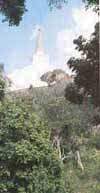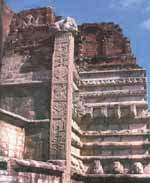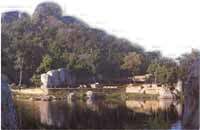| Plus |
|
|||||
|
Mihintale:
The cradle of our civilisation
The great chronicle
The Mahavamsa also states: "The sage Maha Mahinda Thera who
has been 12 years a monk, with four other Theras on the Uposatha
day of the month of Jettha, rose up in the air and departed with
wonderous powers, and then alighted on the Missaka mountain on the
Sila peak at Ambasthala. The historic visit of the sage Mahinda
in the third century B.C. could be considered the greatest of historic
and religious events in Lanka, as its significance was manyfold.
Having met King
Devanampiyatissa (named Beloved of the Gods) at Ambasthala, whilst
he was hunting deer, the sage had a brief conversation to check
on the intelligence and comprehension of the monarch. Thereafter
he delivered the Chulla Hatthi Padopama Sutta which sums up the
essence of Buddhism in a "nut-shell". At the end of the
discourse, the king had expressed his desire to embrace the glorious
Buddha Dharma, and along with him doing so, his entire retinue,
and later all his subjects became Buddhists. This historic
event is important because, it brought out a social and religious
revolution in ancient Lanka. It could rightly be said that, that
was the beginning of the Sinhala Buddhist race up to the advent
of the Portuguese in the island in 1505 A.D. when they came in search
of "Spices and Christians".
The event also
marks the founding of the Buddhist Monastic Order in Lanka. It later
paved the way for the arrival of Arahant Maha Mahinda's sister (daughter
of Emperor Ashoka of India) bringing with her a sapling of the Sri
Maha Bodhi Tree from Buddha Gaya, to be ceremonially planted at
the Maha Mega Uyana, Anuradhapura. Sanghamitta Theri was also responsible
for establishing the Bhikkuni Order (nuns). Arahant Maha
Mahinda's visit ushered a new spirit of Buddhism in the island,
and in this background emerged distinct Sinhala Buddhist art and
sculpture (architecture too), as seen at Mihintale. The several
stupas with ornately decorated Vahalkade as seen at the Kanthaka
Cheitya, balustrades, guard stones, stone reliefs of dwarfs, elephants
and horses, and tall granite stone pillars richly decorated with
flower motifs all chiselled by hand, illustrate the richness of
Buddhist art, besides the skills of the master craftsmen. At Mihintale
today we see ample archaeological evidence to confirm that the whole
area had a massive monastery complete with the Vijja sala hospital,
subterranean drainage. "bath oru" and "Kenda Oru"
(gruel canoes) to meet the needs of thousands of monks. Emperor
Asoka sent his son Mahinda Thera after he witnessed the Kalinga
War, when the river Mahenadi turned red with human blood of his
slain countrymen. The warrior king who saw the Kalinga tragedy turned
a new leaf and decided never to go to battle again. He thereafter
was called Dharma Asoka (the Righteous King). By sending
his son Mahinda to Lanka he strengthened ties between the two countries
and also helped the islanders to learn the Pali language. No story of Ancient Mihintale would be complete without a brief reference to two people who were associated with the preservation and discovery of the monuments, during the first half of the last century. Between 1900 and 1914, it was the fiery orator and Buddhist leader Valisinha Harischandra who agitated with the colonial government to hold back vast extents of temple property that was to be appropriated under the Waste Lands Ordinance. The other person was Prof. Senarat Paranavitane, the Archaeological Commissioner who identified and restored our heritage at this hallowed spot. A mountain carved into a temple By Derrick Schokman
Mountains figure
prominently in the religions of the world. Mystical Mount Meru in
the Himalayas is thought to be the abode of Devas of Hindu mythology.
Mount Sinai is where Jehovah is said to have appeared in a column
of fire and delivered the Ten Commandments to Moses. Mount Olympus
was the legendary home of the Greek Gods. It was on Mount Hira that
Mohammed had a visionary encounter which commanded him to preach
the religion of one god and one only to the people of Mecca. And
it was on the Mihintale mountain that Arahat Mahinda met King Devanampiyatissa
on a Poson Day (circa 240 BC) and introduced Buddhism to Lanka. Stairway In the first
century AD, King Mahadathika Mahanaga created the Ambasthale Dagoba
to commemorate that event. In the third century King Kanitha Tissa
had two prayer ambulatories constructed around the stupa, converting
it into a vatadage. The stone pillars
of those ambulatories, which must have supported a roof of timber,
may still be seen.Crowning the highest peak is the Mahaseya. It
was probably created by King Devanampiyatissa to enshrine a hair
relic of the Buddha. Devotees will
walk around the stupa with bowed heads and folded hands, softly
repeating the Tri Ratna (Triple Gem) or formula of refuge on the
Buddha, Dhamma (His teachings) and the Sangha (priesthood). When excavation
and restoration work was being done on the Mahaseya in the 1960s
by the Department of Archaeology, a small stupa was discovered in
the debris. It was identified as the Mihinduseya, built by King
Uttiya, Devanampiyatissa's brother, to enshrine Mahinda's ashes.
The ashes, along with some bone fragments, beads and trinkets were
found in a polished earthenware casket. Kantaka This stupa
has some of the earliest examples of Sinhalese sculptures. It may
be seen on one of the stelae or frontispieces accompanying the altars
(vahalkada). The distinguishing
motif is a foliage design springing up from a vase with figures
of lions, bulls, elephants and cocks. According to Dr. Senarat Paranavitana,
they are reminiscent of sculptured patterns on the Sanchi gateways
in India. Pabbatarama Two upright
inscribed stone tablets mark the entrance. Inside you will come
upon the Assembly Hall or Sonnipatasala where the monks met for
discussion. Look out for the elevated seat in the middle for the
Chief Priest. There is also
a courtyard which served as a refectory or buth-ge. Two stone troughs
(buth-oru or kenda-oru) may be seen which once contained the rice
and gruel provided for the monks. Surrounding the courtyard are
the chambers (cells) or kutis where the monks resided. Water was brought
to the eating place from the nagapokuna (snake pool) and sinhapokuna
(lion pool), named after the multiheaded cobra and rampant lion
carved on the rock walls of the pools. The water was
conducted to the buth-ge by channels and spouts. Some of those spouts
may still be seen balanced on stone pillars. The Pabbatarama
had its own hospital at the foot of the mountain. The ruins suggest
that rows of separate cells were available for the patients. An interesting
exhibit is a sarcophagus-like medicine boat (beth-oru) cut out of
rock in the shape of a human being. It was used to immerse patients
in herbal oils. Kaludiya
Pokuna In this "entrancing
tarn" as Paranavitana called it are the ruins of the 10th century
Hadayunha Vihara. They are not as extensive as those of the Pabbatarama,
but they do have an interesting exhibit that Pabbatarama does not
have. Under the overhang
of a large boulder is a bath-house very much like the one in the
royal park or magul uyana at Isurumuniya. The dressing room built
of granite slabs must once have been attached to a bathing pool
since silted up. This sylvan retreat is a fitting place to rest tired limbs and ponder on the wonder of Mihintale, a mountain carved by successive rulers into a mighty temple. |
||||||
Copyright © 2001 Wijeya Newspapers
Ltd. All rights reserved. |


